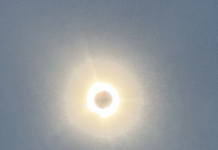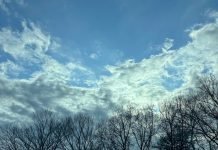Emerald ash borer beetles lay eggs inside ash trees, where the larvae feed beneath the bark and disrupt the tree’s access to nutrients. Strong winds can fall the weakened timber, threatening people and property.
Thus, green ribbons mark ash trees across the metro—a sign of the state’s accelerating emerald ash borer infestation. A ribbon means the tree will disappear over the next few years, as the cities have taken the chainsaw approach rather than using costly pesticides potentially harmful to bees and other insects. By the time the cities finish, 60,000 public trees will be gone. Meanwhile, around 175,000 trees stand vulnerable in private yards, according to Minneapolis officials.
This should all sound eerily familiar.
In the 1970s, Dutch elm disease hit the Twin Cities—where elms comprised 80–90 percent of boulevard trees. Their broad-leafed canopies had to come down. To replace the elms quickly, the cities planted thousands of the now-plagued ash trees, which make up 15–20 percent of boulevard trees, according to recent reporting in the Star Tribune.
Turns out this wasn’t a great idea. So now, Travis McDonald, an arborist with the Davey Tree Expert Company, tells us how we can get started replacing our own ash trees. The key? More biodiversity this time around—with the adage “the right tree in the right place.”
To choose a tree and site in your yard, you should first consult an arborist. McDonald says you’ll take five things into account:
1. The site’s sun and soil conditions. If you plant a tree that’s right for your yard, it will better resist future attacks. All trees need proper sunlight, but species vary according to whether they like wet or dry soil, meaning a low site, where it’s wet, might or might not suit the tree. Effects of sandiness and soil acidity on the tree also differ by species. Avoid nutrient-locked clay soil.
2. The tree’s function. Is it for shade? To screen an ugly view? To improve your home’s energy efficiency? Knowing its function will help you determine tree size and shape.
3. Tree diversity. Pay attention to the trees in your neighborhood and community—and then try to pick something else. Never plant any species exclusively. McDonald’s rule of thumb: no more than 15 percent of a single genus and no more than 5 percent of a single species.
4. Tree placement. Make sure the tree stands away from above-ground hazards such as wires, underground hazards such as pipes, and far enough from your house.
5. Mulch, mulch, mulch. Cover the planting hole with 1–3 inches of shredded hardwood or leaf mulch. But don’t over-mulch the tree. Keep the mulch 2–3 inches away from the trunk or the trunk will rot. Water it regularly during the first year and during droughts in the years following. But take care not to over-water. Opt for a slow-drip irrigation system rather than the occasional blast from your garden hose.
Many trees do well in the Midwest while tolerating urban/suburban conditions. The Davey Tree Expert Company recommends the following, providing the caveat that these are not the only species that could replace an ash. Consult your local arborist for more ideas.
- Princeton Elm
- Ginkgo Tree
- Buckeye Tree
- Kentucky Coffee Tree
- Swamp White Oak
- Hackberry
- Skyline Honey Locust
- Linden Tree
- Japanese Lilac Tree
- Northern Catalpa Tree
- Ironwood
Remember to look at your neighborhood’s trees first and choose something uncommon—lest a new pest arrive and eat through more Minnesota canopy. Let’s prevent whatever the next emerald ash borer may be from wreaking such havoc.






